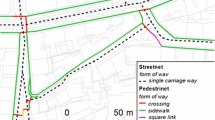Abstract
In this study a landmarks based navigation model considering local context is designed and a prototype is implemented. A route planning model where both the distance of a route and the strength of landmarks along the route are considered when deciding the optimum route to follow is developed. The Dijkstra algorithm is used as the basis and if the route is having more strength related to landmarks, it is prioritize while comparing with the distance. The route’s strength is defined based on number of landmarks visible along it and their salience. The horizontal spread, the height and the visibility of landmarks at different time of the day and the social/cultural significance are considered as attributes which give strength to a landmark. To utilize the mobile screen in effective manner, a map generalization is used to show the optimum path. With landmarks the map becomes congested and difficult to read on mobile screen. Therefore the path is reduced to a linear map which shows the path reducing curves while emphasizing the turns. Douglas–Peucker algorithm is used to derive the linear path. The linear map, which is a schematic representation of the actual map, reduces the path between junctions to straight lines and thereby uses less screen area. The implementation is done using mobile web approach and web services to reduce the platform dependency. OpenStreetMap is used as the main data source with sample local landmarks. All technologies used are free and open source. The application is still being verified and tested in Sri Lanka.









Similar content being viewed by others
References
Fallah, N., Apostolopoulos, I., Bekris, K., & Folmer, E. (2013). Indoor human navigation systems: A survey. Interacting with Computers, 25(1), 21–33. doi:10.1093/iwc/iws010.
Loomis, J. M., Klatzky, R. L., Golledge, R. G., & Philbeck, J. W. (1999). Human navigation by path integration. In R. G. Golledge (Ed.), Wayfinding: Cognitive mapping and other spatial processes (pp. 125–151). Baltimore, MD: Johns Hopkins University Press.
Seamarks/Landmarks. http://wiki.openstreetmap.org/wiki/OpenSeaMap/Landmarks. Accessed 30 Jan 2016.
Siegel, A. W., & White, S. H. (1975). The development of spatial representations of large-scale environments. Advances in Child Development and Behavior, 10, 9–55.
Presson, C. C., & Montello, D. R. (1988). Points of reference in spatial cognition: Stalking the elusive landmark*. British Journal of Developmental Psychology, 6(4), 378–381. doi:10.1111/j.2044-835X.1988.tb01113.x.
Sorrows, M. E., & Hirtle, S. C. (1999). The nature of landmarks for real and electronic spaces. Paper presented at the Proceedings of the International Conference on Spatial Information Theory: Cognitive and Computational Foundations of Geographic Information Science.
Stankiewicz, B. J., & Kalia, A. A. (2007). Acquisition of structural versus object landmark knowledge. Journal of Experimental Psychology: Human Perception and Performance, 33(2), 378–390. doi:10.1037/0096-1523.33.2.378.
Raubal, M., & Winter, S. (2002). Enriching Wayfinding instructions with local landmarks. In M. J. Egenhofer & D. M. Mark (Eds.), Geographic information science: Second international conference, GIScience 2002 Boulder, CO, USA, 25–28 Sept 2002 proceedings (pp. 243–259). Berlin, Heidelberg: Springer.
Nuhn, E., Reinhardt, W., & Haske, B. Generation of landmarks from 3D city models and OSM data In J. Gensel, D. Josselin, & D. Vandenbroucke (Eds.), AGILE’2012 International Conference on Geographic Information Science, Avignon, 24–27 April 2012.
Caduff, D., & Timpf, S. (2005). The landmark spider: Representing landmark knowledge for wayfinding tasks reasoning with mental and external diagrams: Computational modeling and spatial assistance. In T. Barkowsky, C. Freksa, M. Hegarty, & R. Lowe (Eds.), Papers from the 2005 AAAI Spring Symposium (pp. 30–35).
Duckham, M., Winter, S., & Robinson, M. (2010). Including landmarks in routing instructions. Journal of Location Based Services, 4(1), 28–52. doi:10.1080/17489721003785602.
Fang, Z., Li, Q., & Zhang, X. (2011). A multiobjective model for generating optimal landmark sequences in pedestrian navigation applications. International Journal of Geographical Information Science, 25(5), 785–805. doi:10.1080/13658816.2010.500290.
Basiri, A., Winstanley, A., & Amirian, P. (2013). Landmark-based pedestrian navigation. In Proceedings of the 21st GIS Research (GISRUK) Conference, 2013.
Santo, M. A. D., Oliveira, F. H. D., & Wosny, G. C. (2008). Algorithms for automated line generalization in GIS paper presented at the ESRI international user conference. California: San Diego.
Saalfeld, A. (1999). Topologically consistent line simplification with the Douglas–Peucker Algorithm. Cartography and Geographic Information Science, 26(1), 7–18. doi:10.1559/152304099782424901.
Dijkstra, E. W. (1959). A note on two problems in connexion with graphs. [journal article]. Numerische Mathematik, 1(1), 269–271. doi:10.1007/bf01386390.
Douglas, D. H., & Peucker, T. K. (1973). Algorithms for the reduction of the number of points required to represent a digitized line or its caricature. Cartographica: The International Journal for Geographic Information and Geovisualization, 10(2), 112–122. doi:10.3138/FM57-6770-U75U-7727.
Historical Development of the Road Sector Organizations and Road Network http://www.rda.gov.lk/source/about.htm. Accessed 15 Aug 2015.
Sri Lanka Tagging Guidelines. http://wiki.openstreetmap.org/wiki/Sri_Lanka_Tagging_Guidelines. Accessed 20 Jan 2016.
Acknowledgments
This research study is supported by a SLIIT Research Grant (FGSR/RG/2015/02) received from Sri Lanka Institute of Information Technology, Sri Lanka in 2015.
Author information
Authors and Affiliations
Corresponding authors
Rights and permissions
About this article
Cite this article
Chandrasekara, P., Mahaulpatha, T., Thathsara, D. et al. Landmarks based route planning and linear path generation for mobile navigation applications. Spat. Inf. Res. 24, 245–255 (2016). https://doi.org/10.1007/s41324-016-0023-0
Received:
Revised:
Accepted:
Published:
Issue Date:
DOI: https://doi.org/10.1007/s41324-016-0023-0




